Structures plan production tips and tricks
Last updated: 2024-04-29
 User interface
User interface
-
Quick Access Toolbar To add buttons to your quick access toolbar (in the far upper left corner next to the C3D menu) right-click any tool and click Add to Quick Access Toolbar.

-
User Palette
Create your own tool palette to organize tools as you like. Follow the instructions on the User Palette panel page.
- Open any standard toolbar and dock it wherever you like with Ribbon > View tab > Toolbars (far-right button).
-
Selection Cycling If you have trouble selecting a specific object when many objects are on top of each other, toggle on the SELECTIONCYCLING variable using the Ctrl + W or by clicking the button in the Status Bar.

-
Shortcut Keys
Be aware of the available Command shortcuts and hotkeys and be sure to customize your own using Structures shortcut keys .

-
Multiple "viewports" can be shown at once in model space (these are different from sheet layout viewports)
Ribbon > View tab > Model Viewports panel > Viewport Configuration (flyout)
- Adding a folder link to a Civil 3D dialog
 Copy and paste
Copy and paste
-
COPYCLIP OR Ctrl + C
Copies selected objects.
-
COPYBASE OR Ctrl + Shift + C
Copies selected objects about a base point.
-
PASTEORIG (no shortcut)
Pastes at same coordinates as original drawing.
-
PASTECLIP OR Ctrl + V
Pastes objects using the copied base point. If no base point was selected, the lower left corner of the copied objects will be used.
-
PASTEASBLOCK OR Ctrl + Shift + V
Paste objects as a Block. AutoCAD will give it a default name - Select object and look in properties to find its default name. Use RENAME to change the block to a logical naming convention.
-
MATCHPROP (no shortcut)
Copies object properties from one object to another.
In addition to the commands and shortcuts, all of the tools above are available in the Ribbon > Home tab > Clipboard panel
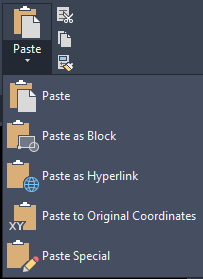
 Basic linework/drafting
Basic linework/drafting
- To draw a utility line, use the Add individual component tool to add all roadway linetypes to your drawing.
- After the utility line is drawn, use the Purge non-structures styles tool to clean unused roadway linetypes.
- To check if an alignment is curved or tangent, attempt to draw a 3-point curve on it. If the curve can't be drawn, it is a tangent line.
-
Drawing complex fractions
In a Details/Architectural template, there are several ways to specify the length of a line. For example, a 5'-4½" length can be entered as:
- 5.375'
- 5'4-1/2
-
5'4.5

In a Layout/Decimal template, you can't use fractional inches. The same distance can only be entered as 5.375.
-
FILLET can be used to trim/extend two lines to a corner (radius = 0)
Alternately TRIM or EXTEND or a combination of two can be used.
- Notice while using TRIM or EXTEND in the command line there is a prompt for a "shift-select" to do the opposite command (i.e. in TRIM, shift-select will do extend)
-
Simple lines or polylines can be joined together using the JOIN command. Joined lines will plot better at corners.
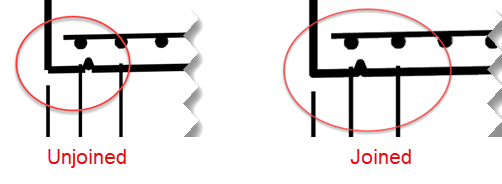
- Take advantage of Layers and their properties to quickly turn off, isolate, or lock objects.
- Freeze layers you don't need (especially in references) to increase drawing performance. Layers can also be frozen within viewports so they won't print in that viewport.
- Turn off layers if you need to clean up the view temporarily
- Lock layers to prevent them from being accidentally changed.
- Isolate layers to fade and lock all other layers. This is useful if you want to edit specific objects that are surrounded by other layers.
You can also isolate objects with the right-click menu. Using this menu will isolate the selected objects, regardless of layer. All other objects will disappear until the isolation is ended.

 Dimensioning
Dimensioning
Editing dimension text
- Use <> as a stand in for the actual dimension length.
- Use \X to add a line of text below the dimension.
-
If the dimension line is not showing up between two lines of dimension text (typically on angular dimensions) this is due to the background masking of the text. You can turn this off in the properties.

Intersecting dimensions
Use the DIMBREAK command to fix dimensions/multileaders that intersect.
Ribbon > Annotate tab > Dimension panel > Break
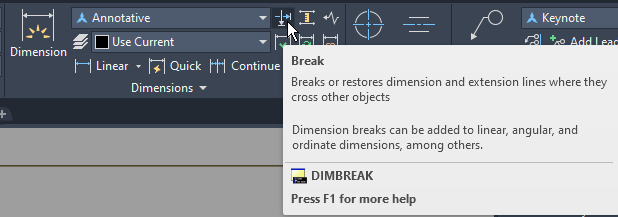
Fix broken dimensions
If a dimension doesn't look right, try removing the dimension overrides
Ribbon > Annotate tab > Dimensions panel (flyout) > Override
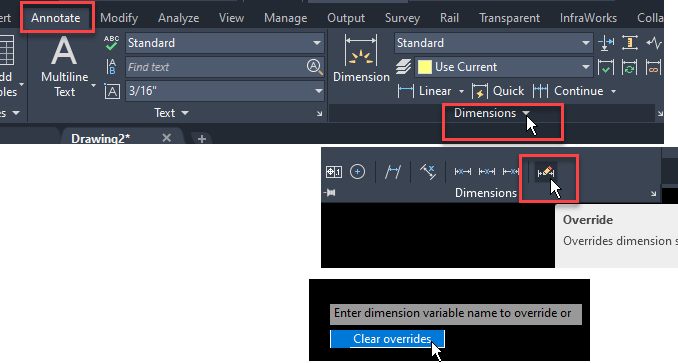
DIMROTATED
Be sure to use DIMROTATED when dimensioning legs that are not aligned (as shown in the image below)
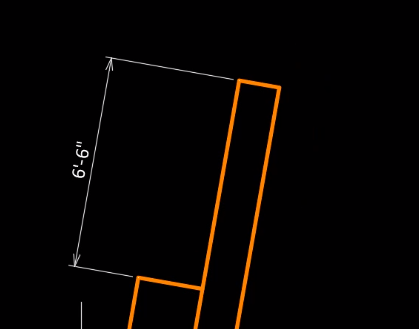
Draw arbitrary/oblique dimensions
- Draw a dimension.
-
Ribbon > Annotate tab > Dimensions panel (flyout) > Oblique
OR DIMEDIT
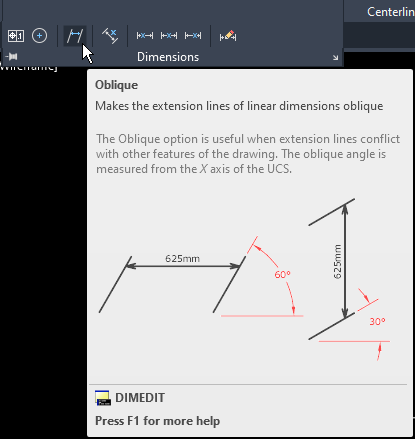
- Select the dimension you want to modify and type an angle for the skew. Note the angles shown in red in the C3D help diagram.
Draw an angular dimension greater than 180
-
Structures Tool Palettes > Anno palette > Quick Annotations > Dimension (flyout) > Angular Dimension
OR DIMANGULAR
- Instead of left-clicking on the two lines to define the angle, right click. Then click on the intersection point of the two angles.
-
Finally, click on the end points of the lines defining your angle, and click again to place the dimension.
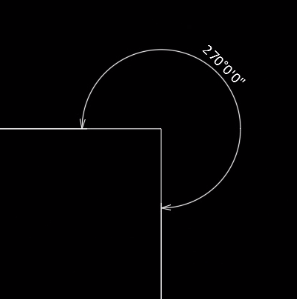
Measure distance along arc
-
Structures Tool Palettes > Anno palette > Quick Annotations > Dimension (flyout) > Angular Dimension
OR DIMARC
Tip: If you only want to measure instead of drawing a dimension for plan production, the Decimal DimensionQuick Annotation will measure in decimals of a foot instead of fractions of an inch.
- P to measure a partial arc
- Click start and end points
Dimension revisions
Sometimes it's necessary to change some or all of the Dimension Text red while leaving the dimension itself black.
- Select the dimension that has revised text.
-
In the Properties Dialog, go to the Text color property in the Text section.
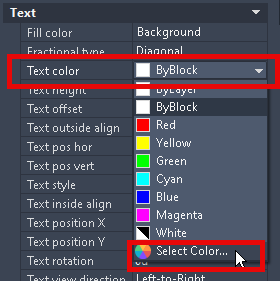
- Select Color...
-
Click the True Color tab and select the color red by either dragging the cursor to the top left or top right of the color selector, or typing 255,0,0 in the RGB Color text field.
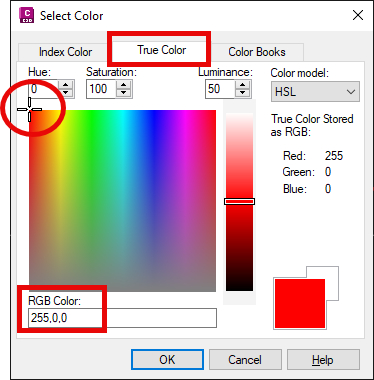
- OK
-
Now all the text in the dimension will be red (and plot red) while the dimension itself will plot according to the dimension's layer (black in this case).

-
If there is text that shouldn't be red:
- Double-click the dimension text to edit it.
- Select the text that should be changed back to ByLayer. In this example we want "REVISED" to be red and "TEXT" to be black.
-
Text Editor > Formatting > Color > ByLayer
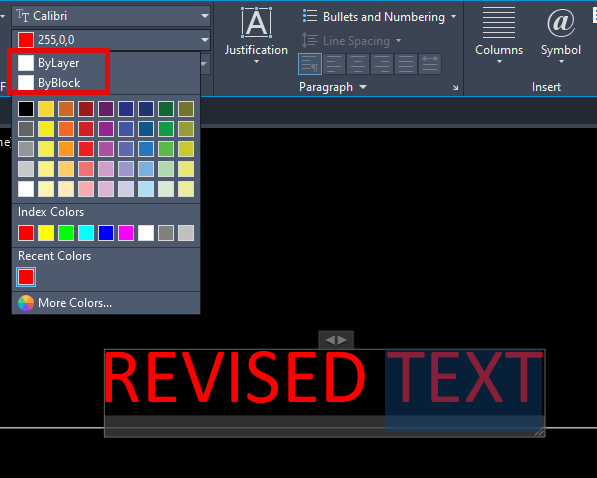
-
Now only the unselected text will plot red.
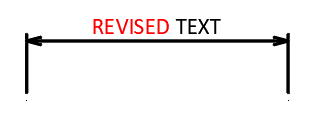
 Text
Text
- TCASE sets text case to fix lowercase text (this can also be done in the right-click menu)
-
Right-click while editing text and turn on the All CAPS option to always type in caps. This option will stay turned on for all future annotating in every drawing.
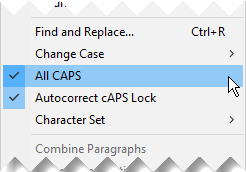
- TXT2MTXT converts a single line text to multiline. This is useful when correcting a file that was converted from MicroStation.
- Parts of text can be changed to plot red (or any color) by changing the font color to True Color.
Select the text that should be a different color.
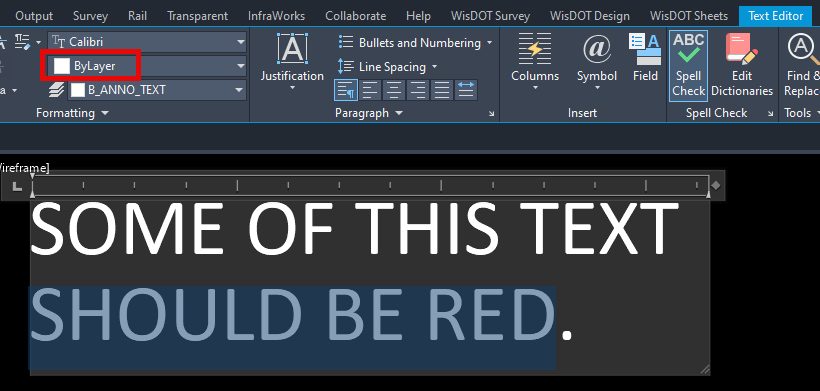
- Text Editor > Formatting > Color > More Colors...
Click the True Color tab and select the color red by either dragging the cursor to the top left or top right of the color selector, or typing 255,0,0 in the RGB Color text field.

Info: Any text can be changed to plot red as described above except single line text and dimension text. Single line text must first be changed to multiline with TXT2MTXT, and dimension text can be changed using the workaround described in the dimension section above.
 Wipeout
Wipeout
Wipeouts are polygonal areas that mask underlying objects with the current background color. The area is bounded by a frame that can be turned on or off. The frame can also set to be visible in Civil 3D and hidden for plotting.
- Ribbon > Annotate tab > Markup panel > Wipeout
OR WIPEOUT - Click points to define the perimeter of the area to be masked.
Alternatively: P to click an existing polyline. - Enter
 Scale a detail in one direction
Scale a detail in one direction
Sometimes it's useful to scale a detail in one direction only, to exaggerate the vertical scale, for example.
- Convert the detail into a block.
- Select all linework. (Don't include any annotations)
- BLOCK
- Enter a name for the block
- Under Base point: check Specify On-screen and click Pick point to define the block base point
- Under Objects make sure Convert to block is ticked.
- OK
- Select the new block and edit the Scale X and/or Scale Y in the properties dialog.